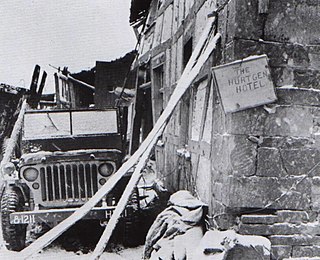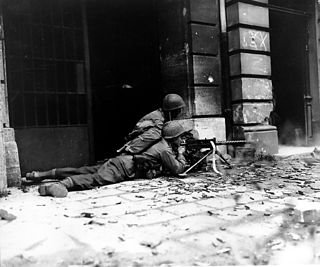Background
After the Wehrmacht took heavy casualties among infantry divisions in the summer of 1944, they started organizing volksgrenadier ("people's grenadier") divisions, which were new infantry divisions with less manpower and equipment, along with a new title to raise morale. Adolf Hitler came up with the name, with volk appealing to German nationalism and grenadier referring to German military traditions. These had fewer soldiers and less heavy equipment than normal infantry divisions, but more automatic weapons (such as the Sturmgewehr 44) and anti-tank weapons (Panzerfaust and Panzerschreck). They also had a shortage of motorized vehicles, relying primarily on horses and to a lesser extent on bicycles. The volksgrenadier formations were put together with young and old conscripts, security troops, former personnel of the Luftwaffe and Kriegsmarine, and, in some cases, they were combined with surviving members of infantry divisions that had been destroyed. The latter received the numbers of the infantry divisions they were combined with, as Hitler wanted to preserve their history, while those that were completely new were generally given a number in the 500 series. Heinrich Himmler and the SS were responsible for overseeing the training of these units, though they remained part of the Wehrmacht.
History
Battle of Nancy
It was created as the 553rd Grenadier Division at the Münsingen training ground from the mobilization wave of July 1944, and was renamed the 553rd Volksgrenadier Division on 9 October 1944. As of early September, when George Patton's U.S. Third Army was preparing to invade Saarland from northeastern France, the 553rd arrived in Saarbrücken as one of the divisions sent to help stop the Allied advance from Paris to the Rhine. In the first days of September the division, along with the 3rd and 15th Panzergrenadier divisions and the 559th Volksgrenadier Division, were assembled in western Germany.
After this they entered France, where the 553rd fought against the forward units of the U.S. Third Army in the area in and around Nancy. In mid-September Patton's Third Army began its advance, and the 553rd Grenadier was ordered by German commanders to hold the Moselle river bridgeheads near the city and Nancy itself at all costs. A Luftwaffe field regiment from the 1st Parachute Army was also assigned to the 553rd for the defense of the city itself, while on their flanks, the 3rd Panzergrenadier Division was holding the riverbank north of Nancy and elements of the 15th Panzergrenadier were holding the south. The American XII Corps began crossing the Moselle river to the north of Nancy with its 80th Infantry Division and to the south with the 35th Infantry, before using the 4th Armored Division to exploit the breakthrough.
After some fighting the Germans were unable to stop the Americans from crossing the river and canals in both the north and south. The bulk of the 553rd Grenadier Division, located in the city, was encircled by them in a double-envelopment. The division attempted to break out of the encirclement to retreat east, while U.S. troops captured Nancy on 15 September 1944. The 553rd held out on the plateau northeast of the city, in the village of Agincourt, before launching a counterattack on 18 September. The German counterattack failed, but the division continued to resist the American advance, even by using old trenches in the area from World War I, and was able to delay the 35th and 80th divisions. The commander of XII Corps, Major General Manton S. Eddy, then brought in the tanks of the 6th Armored Division to assist in the attack, and by 23 September the grenadier division was in danger of being encircled. Colonel Erich Löhr, its commander, gave the order to withdraw on 23 September, for which he was relieved of command by the head of the German 1st Army (and was later court-martialed in 1945). The 553rd was ordered to go on the offensive despite its weakened state after the Battle of Nancy, and it recorded as having lost 319 killed, 1,052 wounded, and 2,125 missing during September 1944. Major General Johannes Bruhn became the new commander of the division after Löhr was relieved.
The division continued fighting the American advance from the Moselle to the Seille river over the next several days, and in a battle near Port-sur-Seille on 8 October 1944, the division sustained large casualties, with the Americans reportedly capturing 1,264 German prisoners. After taking heavy losses in France, including an entire regimental staff, the 553rd Volksgrenadier Division was withdrawn from the front later on 13 October to be combined with a static fortress infantry battalion, two machine gun battalions, some anti-aircraft artillery batteries, and two grenadier training and replacement battalions. When it returned to the front lines by the first week of November the 553rd Volksgrenadier was reassigned from 1st Army to the 19th Army, both part of Army Group G, located near the American-French 6th Army Group.
Saverne Gap
On 13 November elements of the 6th Army Group launched an attack aimed at capturing the Saverne Gap in the Vosges mountains and forcing the German 19th Army out of Alsace. The 553rd Volksgrenadier Division, the 708th Volksgrenadier Division, and a small kampfgruppe (battle group) from the 11th Panzer Division were responsible for holding the city of Saarburg and the approaches to the mountain passes. The 553rd soon encountered the U.S. 44th Infantry Division, which the Germans met with artillery fire as it advanced along the road to Saarburg, while the French 2nd Armored Division went around the city and passed through the Vosges at another location. The 553rd was able to slow down the American infantry for several days until they broke through and surrounded the Germans at Saarburg. By 20 November the German defenses outside the Saverne Gap began disintegrating, but during the night and amidst bad weather, Major General Bruhn led about 2,000 troops out of the encirclement, allowing the remnants of the division to escape. As French forces overran the 553rd Division's last defensive line outside of the mountain pass, Bruhn himself was captured on 22 November 1944, and the Saverne Gap fell under Allied control in the next several days.
Bruhn was replaced by Major General Gerhard Hüther and the nearly destroyed 553rd was temporarily placed under the 361st Volksgrenadier Division. General of Panzer Troops Hermann Balck, who had been the commander of Army Group G in the fall of 1944, wrote in his memoirs after the war that the 553rd Volksgrenadier Division's record of escaping encirclement twice and General Bruhn's leadership deserved recognition. The remains of the 553rd took defensive positions on the other side of the Vosges, near Sarre-Union, with the 361st and the Panzer Lehr Division, before being sent to Stuttgart to rebuild. In December 1944 the division was ordered to the east bank of the Rhine to continue rebuilding. At this point only the 1119th Grenadier Regiment was at full strength, and the 553rd also received regiments from several other units, including an anti-tank and an assault gun battalion.
The Rhine
The division was estimated to have about 3,500 troops in January 1945. When the German Ardennes offensive in the north stalled by the end of December 1944, the German high command decided to launch another offensive further south into Alsace, and split the American forces from the French in the south. Army Group G forces were committed for this operation, called Nordwind . The 553rd Volksgrenadier Division was given the objective of crossing the Rhine and creating a bridgehead in Gambsheim that would be used by Army Group Upper Rhine. The operation began on 1 January 1945, and the 553rd crossed the river and captured Gambsheim on 5 January. Its troops then took up defensive positions and also occupied the town of Herrlisheim and the Steinwald forest. Elements of the 553rd Volksgrenadier and the 10th SS Panzer Division Frundsberg defended Herrlisheim. Later that month two battalions of the U.S. 12th Armored Division attacked their positions, but by 19 January both battalions had been destroyed. Elsewhere, a final German offensive in the Alsace was launched on 24 January that failed to reach its objectives, and German troops in the area withdrew back to the other side of the Rhine.
After the end of Operation Nordwind the division was removed from the front and became the Army Group G reserve. It surrendered to the Allies in Württemberg in May 1945.

The Battle of Hürtgen Forest was a series of battles fought from 19 September to 16 December 1944, between American and German forces on the Western Front during World War II, in the Hürtgen Forest, a 140 km2 (54 sq mi) area about 5 km (3.1 mi) east of the Belgian–German border. It was the longest battle on German ground during World War II and is the longest single battle the U.S. Army has ever fought.

The Battle of Aachen was a battle of World War II, fought by American and German forces in and around Aachen, Germany, between 12 September and 21 October 1944. The city had been incorporated into the Siegfried Line, the main defensive network on Germany's western border; the Allies had hoped to capture it quickly and advance into the industrialized Ruhr Basin. Although most of Aachen's civilian population was evacuated before the battle began, much of the city was destroyed and both sides suffered heavy losses.

The 14th Armored Division was an armored division of the United States Army assigned to the Seventh Army of the Sixth Army Group during World War II. It remains on the permanent roll of the Regular Army as an inactive division, and is eligible for reactivation. The division is officially nicknamed the "Liberators".

Volksgrenadier, also spelt Volks-Grenadier, was the name given to a type of German Army division formed in the autumn of 1944 after the double loss of Army Group Centre to the Soviets in Operation Bagration and the Fifth Panzer Army to the Western Allies in Normandy. The name itself was intended to build morale, appealing at once to nationalism (Volk) and Germany's older military traditions (Grenadier). Germany formed 78 VGDs during the war. Volksgrenadier divisions were professional military formations with standardized weapons and equipment, unlike the unrelated Volkssturm militia.

The Panzer-Lehr-Division was an elite German armoured division during World War II. It was formed in 1943 onwards from training and demonstration troops stationed in Germany, to provide additional armored strength for the anticipated Allied invasion of western Europe. On 4 April 1944, the division was officially designated as the 130th Panzer Division; however, it is usually referred to as the Lehr Division. It was the only Wehrmacht Panzer division to be fully equipped with tanks and with halftracks to transport its mechanized infantry. On several occasions it fought almost to destruction, in particular during Operation Cobra, and by the end of the war in Europe bore little resemblance to the unit that had originally been activated.

The 212th Infantry Division was a German infantry division that fought in World War II. It was destroyed in Lithuania, and reconstituted as the 578th Volksgrenadier Division before being renamed the 212th Volksgrenadier Division.

The 9th Panzer Division was a panzer division of the German Army during World War II. It came into existence after 4th Light Division was reorganized in January 1940. The division was headquartered in Vienna, in the German military district Wehrkreis XVII.

The 12th Infantry Division – later known as the 12th Volksgrenadier Division – was a Wehrmacht military unit of Nazi Germany that fought during World War II. The division was formed in 1934. It participated in the invasion of Poland in 1939 and the 1940 campaign in France and the Low Countries. In the Soviet Union, the division joined Operation Barbarossa. The division was destroyed in the Soviet Operation Bagration in the summer of 1944. The division was re-activated in September 1944 and posted to the newly created Western Front.

The 17th SS Panzergrenadier Division "Götz von Berlichingen" was a German Waffen-SS division that saw action on the Western Front during World War II.

The 183rd Volksgrenadier Division was a German unit during World War II.

Herrlisheim is a commune in the Bas-Rhin department in Grand Est in north-eastern France. The town dates from the 8th century. Herrlisheim was the scene of very heavy fighting during Operation Nordwind, an offensive launched by the German Army during World War II that inflicted considerable damage to the town.

The 272nd Volksgrenadier Division, was a German Army Volksgrenadier division formed following the defeats of the Normandy Campaign in 1944. Composed of men taken from existing Heer (army) units and airmen and sailors retasked to infantry duties, the division fought on the retreating Western Front until it was largely encircled in the Ruhr Pocket in April 1945.
The Wehrmacht forces for the Ardennes Offensive were the product of a German recruitment effort targeting German males between the ages of 16 and 60, to replace troops lost during the past five months of fighting the Western Allies on the Western Front. Although the Wehrmacht was keeping the Allied forces contained along the Siegfried Line, the campaign had cost the Wehrmacht nearly 750,000 casualties, mostly irreplaceable. However, the rapid advance of the Allied armies in August and September after Operation Overlord had created a supply problem for the Allies. By October, the progress of the Western Allies' three army groups had slowed considerably, allowing the Germans to partly rebuild their strength and prepare for the defense of Germany itself. Adolf Hitler decided that the only way to reverse his fortunes would be to launch a counter-offensive on the Western Front, forcing both the United States and Great Britain to an early peace, and allowing the Wehrmacht to shift its forces to the Eastern Front, where it could defeat the much larger Soviet Red Army.

The 31st Infantry Division was a German infantry division of the Army during World War II. It participated in the invasion of Poland in 1939 then the invasion of France and the Low Countries in 1940. As part of Panzergruppe 2. of Army Group Centre, it was involved in the invasion of the Soviet Union in June 1941. After hard fighting throughout 1941 and 1942 it joined the 9th Army and fought in the Battle of Kursk in July and August 1943. Along with the rest of the 9th Army, the division conducted a fighting withdrawal for the remainder of 1943, during which it sustained heavy casualties. In the early stages of the Soviet Operation Bagration of June to August 1944, the 31st Infantry Division was destroyed, a fate which subsequently befell most of Army Group Centre. The division was officially disbanded on 18 July 1944.

Major General Roderick Random Allen was a senior United States Army officer, who commanded the 20th and 12th Armored Divisions during World War II. Under his command of the 12th AD, the division defended Strasbourg from recapture; it provided the armored contingent in the closure of the Colmar Pocket and the liberation of Colmar; it spearheaded General George Patton's drive to the Rhine; captured intact the remaining bridge over the Danube River and broke the German defense line; and played a major part in blocking the Brenner Pass, thereby trapping over a million German soldiers in Italy as the war ended. En route to the Brenner Pass it overran eleven concentration camps at Landsberg, Germany.
The following units and commanders participated in the Lorraine campaign from September 1 to December 18, 1944.
The 361st Infantry Division was an infantry division of the German Army during the Second World War, active from 1943 to 1945. It was redesignated as a Volksgrenadier division in 1944. It saw active service on the Eastern Front when the Soviets launched Operation Bagration, during which it suffered significant losses. It later fought in France before being absorbed by the 559th Volksgrenadier Division on 10 March 1945.

The XIV SS Corps was a short-lived SS corps-level headquarters formed to participate in Operation Nordwind on the Upper Rhine in the winter of 1944-1945 during World War II.
The 549th Volksgrenadier Division was a volksgrenadier infantry division of the German Army during World War II, active from 1944 to 1945. It was formed as the 549th Grenadier Division in July 1944 and became a volksgrenadier division several months later. Fighting on the Eastern Front, it was nearly destroyed in the East Prussian Offensive, with its remnants retreating west and surrendering to American troops at the end of the war.
The 559th Volksgrenadier Division was a volksgrenadier division of the German Army during World War II that fought entirely on the Western Front.














